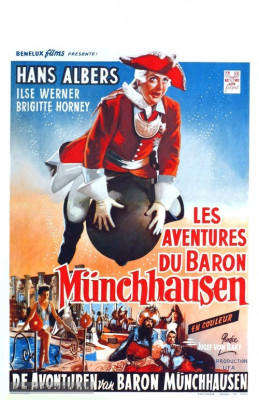| Reviews & Columns |
|
Reviews DVD TV on DVD Blu-ray 4K UHD International DVDs In Theaters Reviews by Studio Video Games Features Collector Series DVDs Easter Egg Database Interviews DVD Talk Radio Feature Articles Columns Anime Talk DVD Savant Horror DVDs The M.O.D. Squad Art House HD Talk Silent DVD
|
DVD Talk Forum |
|
|
| Resources |
|
DVD Price Search Customer Service #'s RCE Info Links |
|
Columns
|
|
|
Münchhausen
Directed by Josef von Báky and originally released without a proper screenplay credit for pacifist Emil and the Detectives author Erich Kästner, the film stars Hans Albers, who also headlines Kino's concurrent Blu-ray of The Man Who Was Sherlock Holmes.
The movie is based on Rudolf Erich Raspe's 1785 novel about a fictional German nobleman, Baron Munchausen's Narrative of his Marvelous Travels and Campaigns in Russia, though it was loosely based on a real baron, Hieronymus Karl Friedrich Freiherr von Münchhausen, known for telling outrageous tall tales; he died in 1797. Raspe's story was published throughout the world in myriad languages, and later other authors expanded upon Münchhausen's exploits, suggesting that he was immortal, alive and well through the nineteenth and even into the twentieth century.
The movie opens at an 18th century ball, where a young woman is clearly attracted to Baron Münchhausen (Albers) though she's already engaged to a younger if less handsome man. In a clever touch, she casually asks him to turn on a light, and the camera cuts away to a modern electrical switch, and then she's seen stepping into a modern automobile. It's present-day (i.e., 1943) Germany, and the ball is a costume party.
The fiancé, however, is eager to learn from the present-day Baron more about his famous ancestor and so, in flashbacks, Münchhausen's famous exploits are retold as the young couple raptly listen.
The story unfolds a bit too leisurely at first, with the best material saved for the last 45 minutes or so, after Münchhausen rides a cannonball on the Turkish front and is imprisoned along with an Italian princess. There, Münchhausen is reunited with longtime friend Christian Kuchenreutter (Hermann Speelmans), inventor of a blunderbuss that can accurately fire bullets up to 100 miles; and, Der Läufer, (Walter Lieck), Münchhausen's runner who can dash hundreds of miles in a matter of minutes. All four eventually escape to Venice, and later Münchhausen and Kuchenreutter fly a hot-air balloon to the moon.
The latter half of the film is on one hand visually more resplendent but also more wistfully poignant. Having gained immortality from the wizard Cagliostro, Münchhausen never ages, but his friends and companions do. He meets up with Casanova, only to find the Great Lover now in late middle age, his looks gone. On the moon Kuchenreutter, already well into middle-age himself by this point in the story, ages one year there for every earth day there. When it's revealed (though the audience has certainly guessed by this time) that the current Baron Münchhausen is the original article himself, talking about his own adventures the whole time, he resolves to resume aging normally, so that together he can grow old with his current wife, whom he married in 1900.
The movie Münchhausen resembles the handful of Technicolor fantasies of Hollywood and Britain in most respects, but still surprises. At the sultan's harem, for instance, dozens of topless women are seen bathing together, a startling sight for any 1940s film. In that sequence we see one of the film's best on-set special effects: Münchhausen makes himself invisible and carries off the Italian princess, who realistically seems to be floating on air.
Sequences on the moon are especially good, reminiscent of the early silent shorts of Georges Méliès, featuring the disembodied head of a moon-woman and foliage resembling Méliès's distinctive set designs. Other tricks are readapted from silent cinema; a split-screen trick where Münchhausen's eyes dart in opposite directions had previously turned up in a Colleen Moore silent comedy, and probably before that as well.
The scenes in Venice are particularly striking, partly filmed during the Carnival, apparently, though also in original footage incorporating the actors and perhaps hundreds of elaborately costumed extras. One can only imagine what filming a Nazi-financed production in fascist Italy must have been like for the cast and crew.
Video & Audio
Münchhausen has been restored to a 116-minute running time, using composite elements of various release versions, though still a bit short of its original 133-minute running time. The Agfa color has also been restored to the extent possible. Unlike Technicolor, which used three strips of black-and-white 35mm and filters, Agfa, as I understand it, was a single-strip process with three emulsion layers using a complex chemical process that required much trial and error before it was perfected. In some scenes the film looks a little brownish but others approach the vividness of original Technicolor prints. The German audio is excellent, as are the English subtitles.
Extra Features
Most of the supplements appear to be ported over from the earlier DVD release. They include a short documentary about the production and restoration; samples of Agfacolor restoration (but, curiously, not including this one); an intriguing 1944 animated short by Hans Held, that appears to utilize rotoscoping; a trailer, and an audio commentary by film historian Samm Deighan.
Parting Thoughts
For those familiar only with Terry Gilliam's uneven but often splendid The Adventures of Baron Münchhausen (1988) may find this even more remarkable and satisfying in some respects. Highly Recommended.
Stuart Galbraith IV is the Kyoto-based film historian currently restoring a 200-year-old Japanese farmhouse.
|
| Popular Reviews |
| Sponsored Links |
|
|
| Sponsored Links |
|
|
| Release List | Reviews | Shop | Newsletter | Forum | DVD Giveaways | Blu-Ray | Advertise |
|
Copyright 2024 DVDTalk.com All Rights Reserved. Legal Info, Privacy Policy, Terms of Use,
Manage Preferences,
Your Privacy Choices | |||||||













